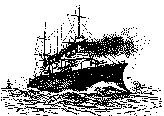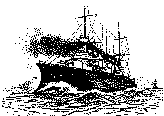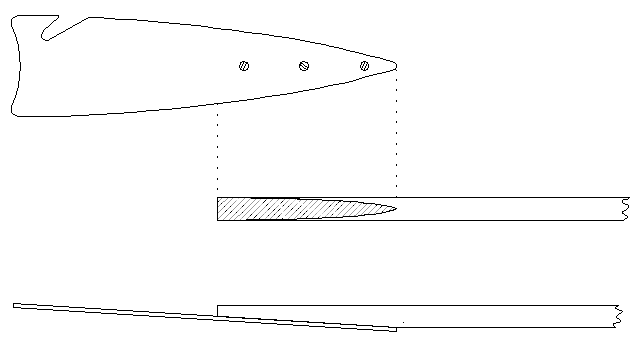| Making Cheap Oars from Lumberyard Materials | |
| By Bill Wallace | |
The notches in the blade of the oar are not my idea, it appeared a long time ago in a wonderful column in Yachting, when it was a good magazine, called "Gadgets and Gilhickies." The hollow in the end is very useful when you are using the oar to fend off, as it will not slip off what you are pushing against the way it would if it were a typical, rounded, blade tip. The other notch turns out to be very useful as a boathook. I suspect it didn't catch hold because the boathook notch made the blade very fragile; a hunk of it would break off. Fiberglass and epoxy, not invented in those days, solve the problem nicely.
Go by your local lumberyard, or big hardware store, and buy a couple of what they call closet poles-- the things your coat hangers hang from. They are very strong indeed! Plane a tapered flat on each, as show in the sketch. The blades are made of a good grade of 1/4" plywood, covered with glass cloth and epoxy. Screw and glue them to the shafts. I suspect the screws add little or nothing to the strength, just hold things together while the glue is setting up. You might want to set them up so that, when you are rowing, the boathook notch is up, so there is a port and starboard oar. The slight angle of the blade with respect to the shaft seems not to influence performance. I have no strong opinion on which side of the oar should face aft.... I doubt the average oarsman-- or the average oarlocks-- could break the blade loose in normal use. These oars are pretty strong, more than adequate for a dinghy, unless you have an Olympic oarsman. For a bigger boat, you might want to upsize the specs. And I suppose you could glass the shafts for a foot or two in the way of the oarlock, where the forces and the wear are greatest. I never have done it. Forgive, please, the lack of dimensions. What you really want is the idea.... By the way, on a small dinghy I have been very happy with nylon oarlocks. Again, no Olympians, please. I have also been very happy using thole pins-- removable ones. They will frustrate the dickens out of you and/or make a good oarsman out of you, one who feathers beautifully. Also, you owe it to yourself to have a an oarlock or thole pins on the transom for sculling. This is very easy, once you have learned the silly trick. This construction method can also be used to make cheap canoe and kayak paddles! This is uncopyrighted and unpatented by Bill Wallace, but please give me credit for keeping the idea alive. | |
Bill Wallace | |
 Back to John's Nautical Page
Back to John's Nautical Page

|
| Send comments to John Kohnen, jkohnen@boat-links.com |

